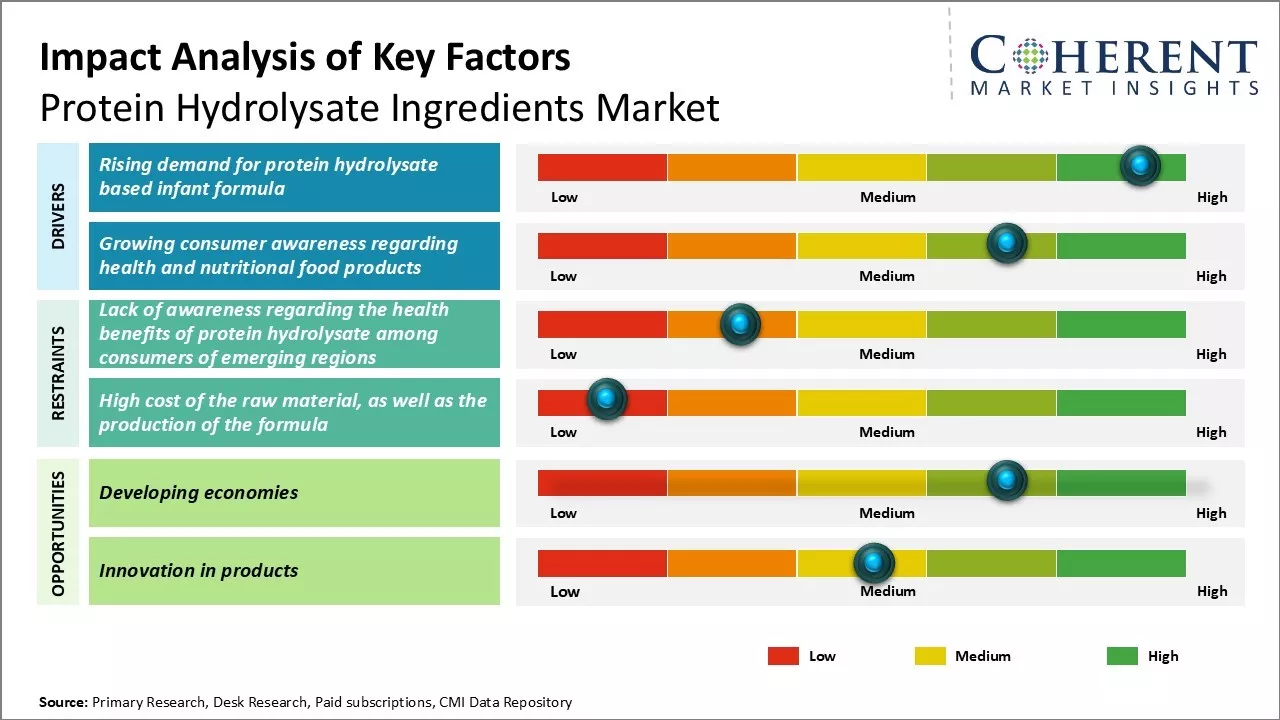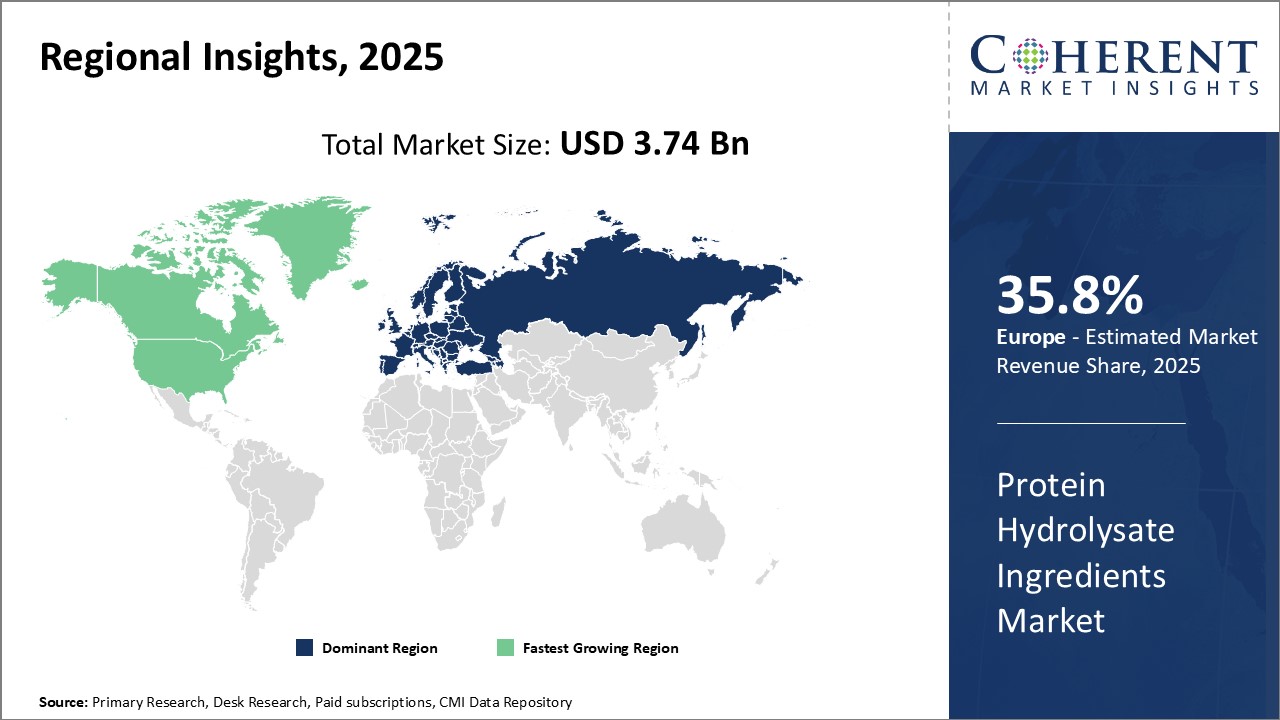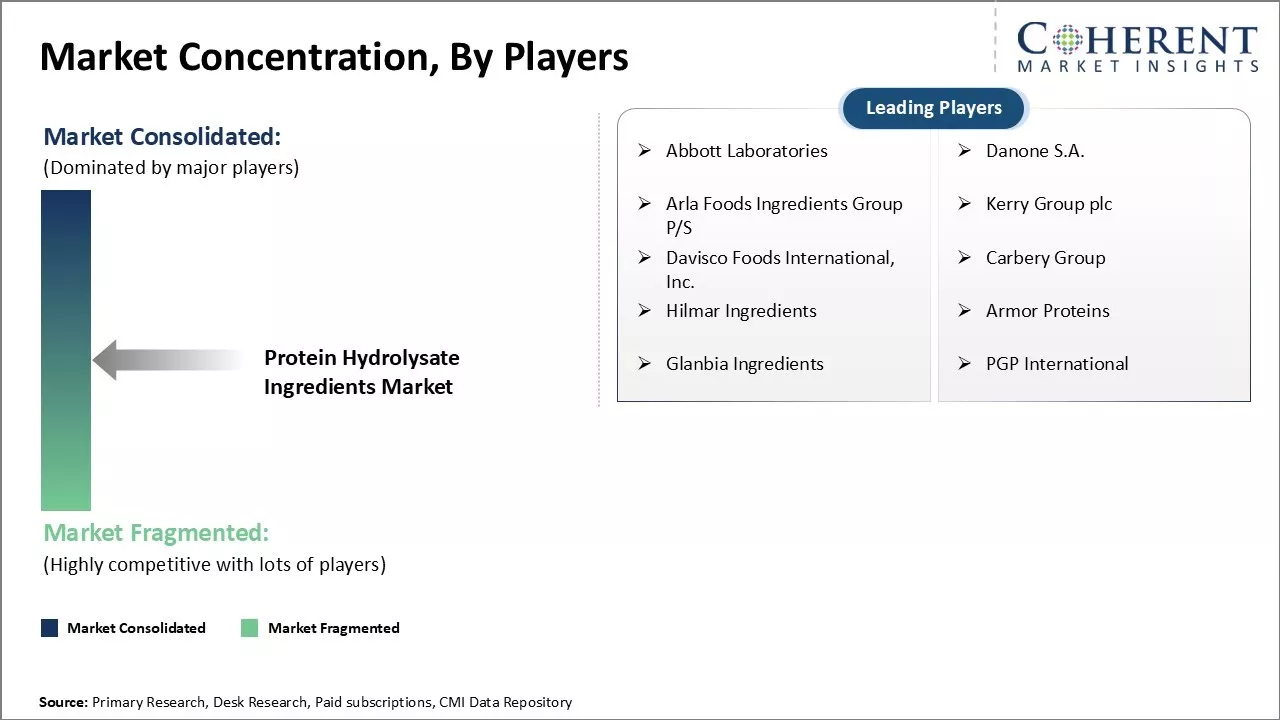The protein hydrolysate ingredients market is expected to generate USD 5.44 billion by 2032 from an initial value of USD 3.74 billion in 2025 while demonstrating a 5.5% CAGR throughout this period.

Discover market dynamics shaping the industry: Download Free Sample
Market Overview
The protein hydrolysate ingredients market is noticed to have a consistent growth due to the increasing consumer preference for nutritional supplements and specialty foods. Protein hydrolysates are widely adopted in formulations targeted at infants, elderly individuals, athletes, and patients with digestive concerns. Innovation in product delivery and functional blends has enabled market players to expand their offerings across different age groups and dietary needs. For instance, protein-rich functional foods in India have seen a double-digit growth over the last two years, signaling a strong consumer shift toward preventative health and wellness.
|
Current Events |
Description and its impact |
|
Technological Innovations in Production Processes
|
|
|
Sustainability Pressures Redefining Sourcing Strategies |
|
Uncover macros and micros vetted on 75+ parameters: Get instant access to report
Protein Hydrolysate Ingredients Market Insights, by Ingredients Type- Consumer demand drives the Whey Protein Hydrolysate segment
In terms of ingredient type, whey protein hydrolysate segment is estimated to contribute the highest market share of 43.5% in 2025, owing to its widespread demand from consumers. Whey protein hydrolysate is highly soluble and easily digestible, making it suitable for a variety of consumer groups. It is often added to food products that target health-conscious consumers, bodybuilders and athletes. The growing health and wellness trend has boosted its usage in dietary supplements, sports nutrition products and functional foods. Many consumers also perceive whey protein hydrolysate to be more hypoallergenic than other types of protein. For instance, in November 2024, Arla Foods Ingredients introduced Lacprodan DI-3092, a new whey protein hydrolysate which provides 10 grams of protein per 100 milliliters, further positively influencing the protein hydrolysate ingredients market forecast.
Protein Hydrolysate Ingredients Market Insights, by Product Form- Powder form drives versatility in Protein Hydrolysate Ingredients applications
In terms of product form, powder segment is estimated to contribute the highest market share of 48% in 2025, owing to its versatile nature. The powdered form extends the shelf life of protein hydrolysate ingredients while facilitating their easy handling, dosing and transport. For instance, protein powder has a shelf life of 9–19 months when stored under normal conditions. It can be conveniently mixed into various food and beverage formulations during processing with minimal impact on texture or viscosity. This allows protein hydrolysate powder to be utilized across a wide range of applications ranging from prepared meals and snacks to nutritional supplements and clinical nutrition products, further driving the protein hydrolysate ingredients market growth.
Protein Hydrolysate Ingredients Market Insights, by Application- Clinical applications drive growth in Infant Formula segment
In terms of application, infant formula segment is estimated to contribute the highest market share of 52% in 2025, owing to the critical importance of clinical nutrition during infancy. Infant formulas are carefully engineered to mimic the nutritive and bioactive components of human breast milk. This includes utilizing protein hydrolysate ingredients to facilitate easier digestion in new born babies. The low-allergenic and highly soluble properties of various protein hydrolysates help infant formulas support appropriate growth and development during the vulnerable early months. With growing global awareness about the significance of first 1000 days of life, demand for specialized clinically-proven infant formulas continues rising. Manufacturers further innovate with formulations containing prebiotics and probiotics to establish long-term gut and immune health. In December 2024, the US Food and Drug Administration approved Arla Foods Ingredients' whey protein hydrolysates for use in infant formula, further enhancing protein hydrolysate ingredients market share.

Need a Different Region or Segment? Download Free Sample
Europe Protein Hydrolysate Ingredients Market Ingredients Analysis and Trends:
Europe is expected to account for the greatest revenue share, with 35.8% in 2025. Europe is known for its exception infant formulas for its high-quality organic ingredient and strict adherence to nutritional standards. Many European brands producing infant formulars such as HiPP and Holle, prioritize organic milk and balanced nutritional profiles to support baby’s growth. These infant formulas comprise of probiotics, prebiotics and mandatory DHA which is essential for brain and eye development. A protein hydrolysate infant formula offers complete nutrition for infants, especially for kids who are allergic to cow’s milk protein. In 2024, Hyvital® Whey HA 300, a protein hydrolysate is developed for infants and follow-on formulas, has received approval for the use all across European Union.
Moreover, a study by Glanbio Nutritionals states that Europeans consume more protein shake from powder (Germany and France), RTD protein shakes (Sweden), protein pancakes (UK) and protein bars (UK, Germany, and Italy), further accelerating the protein hydrolysate ingredients market revenue.
North America Protein Hydrolysate Ingredients Market Trends:
The North American region is expected to have a significant growth in the protein hydrolysate ingredients market in the forecast period. The protein consumers for America looks certain protein hydrolysate factors including sports nutrition, increased digestion and allergy-friendly. Its is widely used as flavour enhances in food, hypoallergenic diets and even in cosmetic products. For instance, in 2024, FDA has approved Arla Food’s why protein hydrolysates for infant formula, which helps in allergy management and gut comfort for US infants. It also is greatly used in sports nutrition, particularly by athletes. Product sales increase because more people participate in the growing number of marathons and charity runs along with lifestyle sporting events. The American companies behind these operations allocate substantial financial resources for AI-based product design advancements and research development, further positively enhancing the protein hydrolysate ingredients market demand.
United States Protein Hydrolysate Ingredients Market Trends
Protein hydrolysates are commonly used in medical nutrition, especially for people with specific dietary needs such as malabsorption issues, protein deficiency, or as part of clinical nutrition for critical patients. Besides this, the increasing penetration towards plant-based protein is augumenting the protein hydrolysate ingredients market share. For instance, Parabel USA Inc. offers a neutral-flavored pure protein hydrolysate derived from water lentils, serving as an allergen-free alternative to other plant-based proteins like soy and pea.
Germany Protein Hydrolysate Ingredients Market Trends
The growth of the protein hydrolysate ingredients market in Germany is driven by several key factors, including increasing demand for medical nutrition, sports supplements, and personalized nutrition. According to Coherent Market Insights, Germany boasts 33 protein hydrolysate suppliers, exporting to 32 global buyers. Between October 2023 and September 2024, four suppliers were active, with M S SIGMA ALDRICH INTERNATIONAL GMB, DANSTAR FERMENT A G, and STOCKMEIER FOOD GMBH collectively accounting for 91% of Germany's protein hydrolysate exports.
Protein hydrolysates are commonly used in medical nutrition products, especially for individuals with specific health conditions like malabsorption, gastrointestinal disorders, or those recovering from surgery. Hydrolyzed proteins are easier to digest and absorb, making them an ideal choice for patients who need targeted nutritional support.
Example: Fresenius Kabi's Fresubin® medical nutrition product line contains hydrolyzed proteins for individuals with gastrointestinal disorders or malabsorption issues. It is used in hospitals and home care for patients requiring enteral feeding.
In the sports nutrition industry, protein hydrolysates are popular because they provide quick absorption and help promote muscle recovery and growth. They are commonly found in protein powders, shakes, and bars used by athletes and fitness enthusiasts.
Example: In November 2022, Myprotein launched a limited-edition Black Cherry Clear Whey Isolate. Using premium hydrolyzed whey protein isolate, it offers a lighter, juice-like alternative to traditional shakes, with added anti-inflammatory properties for the perfect workout.

Get actionable strategies to beat competition: Download Free Sample
Top Strategies Followed by Protein Hydrolysate Ingredients Market Players
Established Players: R&D Investment
Leading companies in the protein hydrolysate ingredients market extensively focus on research and development to innovate new products with high performance.
Mid-Level Players: Cost-Effective Solutions
Mid-sized companies aim to deliver quality protein hydrolysate ingredients at affordable prices. They target price-sensitive consumer segments in developing markets. For example, Fonterra focuses on easy-to-digest and nutritious products for children and the elderly. Its affordable range has increased sales volumes in Asia and Latin America.
Small-Scale Players: Niche Specialization
Small players occupy niche segments left untapped by larger corporations. Madhushree Organics produces non-genetically modified organism, soy-free, and corn-free products. It caters to consumers with allergies. Prodigy Nutrition specializes in cold-processed protein powders without additives or preservatives.
Key Developments
Protein Hydrolysate Ingredients Market Report Coverage
| Report Coverage | Details | ||
|---|---|---|---|
| Base Year: | 2024 | Market Size in 2025: | USD 3.74 Bn |
| Historical Data for: | 2020 To 2024 | Forecast Period: | 2025 To 2032 |
| Forecast Period 2025 to 2032 CAGR: | 5.5% | 2032 Value Projection: | USD 5.44 Bn |
| Geographies covered: |
|
||
| Segments covered: |
|
||
| Companies covered: |
Abbott Laboratories, Danone S.A., Arla Foods Ingredients Group P/S, Kerry Group plc, Davisco Foods International, Inc., Carbery Group, Hilmar Ingredients, Armor Proteins, Glanbia Ingredients, and PGP International |
||
| Growth Drivers: |
|
||
| Restraints & Challenges: |
|
||
Uncover macros and micros vetted on 75+ parameters: Get instant access to report
Market Driver - Rising demand for protein hydrolysate based infant formula
With the growing number of working women and dual earning families, the demand for infant formula has seen a steady rise over the past decade. Parents are always looking for products which can provide optimum nutrition to their babies in their absence and help in proper growth and development. Protein hydrolysate based infant formula has emerged as a popular choice among them as it is easy to digest and has hypoallergenic properties which reduce the risk of allergies in babies. These formulae are derived from extensively hydrolyzed cow's milk or soy protein, which makes them more tolerable for babies who are at risk of developing cow's milk protein allergy or soy protein intolerance.
For instance, a greater number of babies is being diagnosed with cow's milk protein allergy globally each year. For example, according to a 2020 report by non-profit organization Nutrition International, around 2-7% of infants suffer from cow's milk protein allergy in different parts of the world.
Market Challenge - Lack of awareness regarding the health benefits of protein hydrolysate among consumers of emerging regions
One of the major challenges faced by the protein hydrolysate ingredients market is the lack of awareness among consumers in emerging regions about the various health benefits of protein hydrolysate. While consumers in developed markets are well educated about the nutritional advantages of using hydrolyzed proteins, consumers in developing Asian, Latin American and African countries still have low knowledge regarding how protein hydrolysates can help in improving digestion, muscle gain and overall wellness. For instance, data released in 2022, According to the United Nations Food and Agriculture Organization, 36.6% of the world's population faced moderate or severe food insecurity in 2020 due to economic slowdowns caused by the Covid-19 pandemic.
Market Opportunity - Developing economies for market
One of the major opportunities for the protein hydrolysate ingredients market lies in the developing economies across Asia, Latin America, Africa and Eastern Europe. With rising affluence, changing food consumption patterns and growing health consciousness, consumers in these developing nations are increasingly spending on nutrition-rich functional foods and nutraceuticals. The young urban populations in countries like India, Brazil, Indonesia and Nigeria present a huge untapped market for protein hydrolysate products. A recent report from the United Nations World Food Programmed stated that in 2021, the number of undernourished people in India increased by around 46 million compared to the previous year. This underscores the immense protein deficiency challenges faced in South Asia. The fast-growing middle class in India has shown increasing affinity for protein-rich packaged food options. Protein hydrolysates can certainly play a key role in helping resolve nutritional inadequacies and developing newer consumer product categories suited for local tastes.
Primary Research Interviews with Following Stakeholders
Databases
Magazines
Journals
Newspapers
Associations
Public Domain Sources
Share
Share
About Author
Vidyesh Swar is a seasoned Consultant with a diverse background in market research and business consulting. With over 6 years of experience, Vidyesh has established a strong reputation for his proficiency in market estimations, supplier landscape analysis, and market share assessments for tailored research solution. Using his deep industry knowledge and analytical skills, he provides valuable insights and strategic recommendations, enabling clients to make informed decisions and navigate complex business landscapes.
Missing comfort of reading report in your local language? Find your preferred language :
Transform your Strategy with Exclusive Trending Reports :
Frequently Asked Questions
Joining thousands of companies around the world committed to making the Excellent Business Solutions.
View All Our Clients